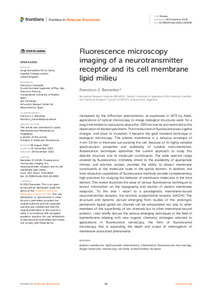Por favor, use este identificador para citar o enlazar este ítem:
https://repositorio.uca.edu.ar/handle/123456789/18149| Título: | Fluorescence microscopy imaging of a neurotransmitter receptor and its cell membrane lipid milieu | Autor: | Barrantes, Francisco José | Palabras clave: | MEMBRANA PLASMATICA; INTERACCIONES PROTEÍNA-PROTEÍNA; COLESTEROL; NANOSCOPIA; MICROSCOPIO FLUORESCENTE; RECEPTOR DE ACETILCOLINA | Fecha de publicación: | 2022 | Editorial: | Frontiers Media | Cita: | Barrantes, F. J. Fluorescence microscopy imaging of a neurotransmitter receptor and its cell membrane lipid milieu [en línea]. Frontiers in Molecular Biosciences. 2022, 9:1014659. doi: 10.3389/fmolb.2022.1014659. Disponible en: https://repositorio.uca.edu.ar/handle/123456789/18149 | Resumen: | Abstract: Hampered by the diffraction phenomenon, as expressed in 1873 by Abbe, applications of optical microscopy to image biological structures were for a long time limited to resolutions above the ~200 nm barrier and restricted to the observation of stained specimens. The introduction of fluorescence was a game changer, and since its inception it became the gold standard technique in biological microscopy. The plasma membrane is a tenuous envelope of 4 nm–10 nm in thickness surrounding the cell. Because of its highly versatile spectroscopic properties and availability of suitable instrumentation, fluorescence techniques epitomize the current approach to study this delicate structure and its molecular constituents. The wide spectral range covered by fluorescence, intimately linked to the availability of appropriate intrinsic and extrinsic probes, provides the ability to dissect membrane constituents at the molecular scale in the spatial domain. In addition, the time resolution capabilities of fluorescence methods provide complementary high precision for studying the behavior of membrane molecules in the time domain. This review illustrates the value of various fluorescence techniques to extract information on the topography and motion of plasma membrane receptors. To this end I resort to a paradigmatic membrane-bound neurotransmitter receptor, the nicotinic acetylcholine receptor (nAChR). The structural and dynamic picture emerging from studies of this prototypic pentameric ligand-gated ion channel can be extrapolated not only to other members of this superfamily of ion channels but to other membrane-bound proteins. I also briefly discuss the various emerging techniques in the field of biomembrane labeling with new organic chemistry strategies oriented to applications in fluorescence nanoscopy, the form of fluorescence microscopy that is expanding the depth and scope of interrogation of membrane-associated phenomena. | URI: | https://repositorio.uca.edu.ar/handle/123456789/18149 | Disciplina: | MEDICINA | DOI: | 10.3389/fmolb.2022.1014659 | Derechos: | Acceso abierto | Fuente: | Frontiers in Molecular Biosciences. 2022, 9:1014659 |
| Aparece en las colecciones: | Artículos |
Ficheros en este ítem:
| Fichero | Descripción | Tamaño | Formato | |
|---|---|---|---|---|
| fluorescence-microscopy-imaging-neurotransmitter.pdf | 1,45 MB | Adobe PDF |  Visualizar/Abrir |
Este ítem está sujeto a una Licencia Creative Commons

